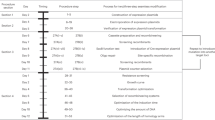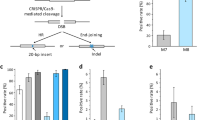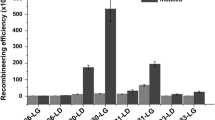Abstract
Homologous recombination-based recombineering is a widely used DNA cloning and modification technique; recombineering efficiency improvement would be helpful for high-throughput DNA manipulation. Escherichia coli primase DnaG variants, such as DnaG Q576A and DnaG K580A, increase the recombineering efficiency via impairment of the interaction between primase and the replisome and boost the loading of more ssDNA on the replication fork. Bacterial adaptive immunity origin CRISPR-Cas9 is emerging as a powerful genome editing strategy. In this study, ssDNA recombineering and CRISPR-Cas9 were combined for the generation of DnaG variants. The tightly regulated Red operon expression cassette and tightly regulated Cas9 expression cassette were integrated into one chloroamphenicol resistance, p15A replicon-based vector. A self-curing, kanamycin resistance, p15A replicon-based plasmid was applied for the plasmid elimination after genome editing. The genome editing efficiency was as high as 100%. The recombineering efficiency of the strains harboring the DnaG variants was assayed via the kanamycin resistance gene repair as well as the chromosomal gene deletion experiments. The established genome editing strategy will expedite the DnaG structure and function relationship study as well as the metabolic engineering and synthetic biology applications.





Similar content being viewed by others
References
Barrangou R, van Pijkeren JP (2016) Exploiting CRISPR-Cas immune systems for genome editing in bacteria. Curr Opin Biotechnol 37:61–68. https://doi.org/10.1016/j.copbio.2015.10.003
Chen Z, Ling W, Shang G (2016) Recombineering and I-SceI-mediated Pseudomonas putida KT2440 scarless gene deletion. FEMS Microbiol Lett 363:fnw231. https://doi.org/10.1093/femsle/fnw231
Cobb RE, Wang Y, Zhao H (2015) High-efficiency multiplex genome editing of Streptomyces species using an engineered CRISPR/Cas system. ACS Synth Biol 4:723–728. https://doi.org/10.1021/sb500351f
Cong L, Ran FA, Cox D, Lin S, Barretto R, Habib N, Hsu PD, Wu X, Jiang W, Marraffini LA, Zhang F (2013) Multiplex genome engineering using CRISPR/Cas systems. Science 339:819–823. https://doi.org/10.1126/science.1231143
Cronan JE (2006) A family of arabinose-inducible Escherichia coli expression vectors having pBR322 copy control. Plasmid 55:152–157
Datsenko KA, Wanner BL (2000) One-step inactivation of chromosomal genes in Escherichia coli K-12 using PCR products. Proc Natl Acad Sci U S A 97:6640–6645
DiCarlo JE, Norville JE, Mali P, Rios X, Aach J, Church GM (2013) Genome engineering in Saccharomyces cerevisiae using CRISPR-Cas systems. Nucleic Acids Res 41:4336–4343. https://doi.org/10.1093/nar/gkt135
Ellis HM, Yu D, DiTizio T, Court DL (2001) High efficiency mutagenesis, repair, and engineering of chromosomal DNA using single-stranded oligonucleotides. Proc Natl Acad Sci U S A 98:6742–6746
Grzybek M, Golonko A, Gorska A, Szczepaniak K, Strachecka A, Lass A, Lisowski P (2018) The CRISPR/Cas9 system sheds new lights on the biology of protozoan parasites. Appl Microbiol Biotechnol 102:4629–4640. https://doi.org/10.1007/s00253-018-8927-3
Hille F, Richter H, Wong SP, Bratovic M, Ressel S, Charpentier E (2018) The biology of CRISPR-Cas: backward and forward. Cell 172:1239–1259. https://doi.org/10.1016/j.cell.2017.11.032
Hsu PD, Lander ES, Zhang F (2014) Development and applications of CRISPR-Cas9 for genome engineering. Cell 157:1262–1278. https://doi.org/10.1016/j.cell.2014.05.010
Jiang W, Bikard D, Cox D, Zhang F, Marraffini LA (2013) RNA-guided editing of bacterial genomes using CRISPR-Cas systems. Nat Biotechnol 31:233–239. https://doi.org/10.1038/nbt.2508
Jiang Y, Chen B, Duan C, Sun B, Yang J, Yang S (2015) Multigene editing in the Escherichia coli genome via the CRISPR-Cas9 system. Appl Environ Microbiol 81:2506–2514. https://doi.org/10.1128/AEM.04023-14
Jinek M, Chylinski K, Fonfara I, Hauer M, Doudna JA, Charpentier E (2012) A programmable dual-RNA-guided DNA endonuclease in adaptive bacterial immunity. Science 337:816–821. https://doi.org/10.1126/science.1225829
Kolisnychenko V, Plunkett G 3rd, Herring CD, Feher T, Posfai J, Blattner FR, Posfai G (2002) Engineering a reduced Escherichia coli genome. Genome Res 12:640–647
Kuhlman TE, Cox EC (2010) Site-specific chromosomal integration of large synthetic constructs. Nucleic Acids Res 38:e92. https://doi.org/10.1093/nar/gkp1193
Lajoie MJ, Gregg CJ, Mosberg JA, Washington GC, Church GM (2012) Manipulating replisome dynamics to enhance lambda Red-mediated multiplex genome engineering. Nucleic Acids Res 40:e170. https://doi.org/10.1093/nar/gks751
Mosberg JA, Lajoie MJ, Church GM (2010) Lambda red recombineering in Escherichia coli occurs through a fully single-stranded intermediate. Genetics 186:791–799. https://doi.org/10.1534/genetics.110.120782
Murphy KC (1998) Use of bacteriophage λ recombination functions to promote gene replacement in Escherichia coli. J Bacteriol 180:2063–2071
Murphy KC (2016) λ recombination and recombineering. EcoSal Plus. https://doi.org/10.1128/ecosalplus.ESP-0011-2015
Oh JH, van Pijkeren JP (2014) CRISPR-Cas9-assisted recombineering in Lactobacillus reuteri. Nucleic Acids Res 42:e131. https://doi.org/10.1093/nar/gku623
Reisch CR, Prather KL (2015) The no-SCAR (scarless Cas9 assisted recombineering) system for genome editing in Escherichia coli. Sci Rep 5:15096. https://doi.org/10.1038/srep15096
Ronda C, Pedersen LE, Sommer MO, Nielsen AT (2016) CRMAGE: CRISPR optimized MAGE recombineering. Sci Rep 6:19452. https://doi.org/10.1038/srep19452
Sambrook J, Russell DW (2001) Molecular cloning: a laboratory manual, 3rd edn. Cold Spring Harbor Laboratory, Cold Spring Harbor
Sawitzke JA, Costantino N, Li XT, Thomason LC, Bubunenko M, Court C, Court DL (2011) Probing cellular processes with oligo-mediated recombination and using the knowledge gained to optimize recombineering. J Mol Biol 407:45–59. https://doi.org/10.1016/j.jmb.2011.01.030
Sharan SK, Thomason LC, Kuznetsov SG, Court DL (2009) Recombineering: a homologous recombination-based method of genetic engineering. Nat Protoc 4:206–223. https://doi.org/10.1038/nprot.2008.227
Shi TQ, Liu GN, Ji RY, Shi K, Song P, Ren LJ, Huang H, Ji XJ (2017) CRISPR/Cas9-based genome editing of the filamentous fungi: the state of the art. Appl Microbiol Biotechnol 101:7435–7443. https://doi.org/10.1007/s00253-017-8497-9
Sun Z, Deng A, Hu T, Wu J, Sun Q, Bai H, Zhang G, Wen T (2015) A high-efficiency recombineering system with PCR-based ssDNA in Bacillus subtilis mediated by the native phage recombinase GP35. Appl Microbiol Biotechnol 99:5151–5162. https://doi.org/10.1007/s00253-015-6485-5
Tang Q, Lou C, Liu SJ (2017) Construction of an easy-to-use CRISPR-Cas9 system by patching a newly designed EXIT circuit. J Biol Eng 11(32):32. https://doi.org/10.1186/s13036-017-0072-5
Tougu K, Marians KJ (1996) The extreme C terminus of primase is required for interaction with DnaB at the replication fork. J Biol Chem 271:21391–21397
van Pijkeren JP, Britton RA (2012) High efficiency recombineering in lactic acid bacteria. Nucleic Acids Res 40:e76. https://doi.org/10.1093/nar/gks147
Wang HH, Isaacs FJ, Carr PA, Sun ZZ, Xu G, Forest CR, Church GM (2009) Programming cells by multiplex genome engineering and accelerated evolution. Nature 460:894–898. https://doi.org/10.1038/nature08187
Zhang Q, Yan Z, Xu Y, Sun J, Shang G (2017) Characterization of inducible ccdB gene as a counterselectable marker in Escherichia coli recombineering. Curr Microbiol 74:961–964. https://doi.org/10.1007/s00284-017-1273-3
Acknowledgements
We thank Dr. John Cronan, Dr. Thomas Kuhlman, and Dr. Barry Wanner for kindly providing the plasmids in this research. Funding was supported by the National Natural Science Foundation of China (NSFC 81273412).
Author information
Authors and Affiliations
Corresponding author
Ethics declarations
Ethical approval
This article does not contain any studies with human participants or animals performed by any of the authors.
Conflict of interest
The authors declare that they have no conflict of interest.
Additional information
Publisher’s note
Springer Nature remains neutral with regard to jurisdictional claims in published maps and institutional affiliations.
Electronic supplementary material
ESM 1
(PDF 782 kb)
Rights and permissions
About this article
Cite this article
Li, J., Sun, J., Gao, X. et al. Coupling ssDNA recombineering with CRISPR-Cas9 for Escherichia coli DnaG mutations. Appl Microbiol Biotechnol 103, 3559–3570 (2019). https://doi.org/10.1007/s00253-019-09744-9
Received:
Revised:
Accepted:
Published:
Issue Date:
DOI: https://doi.org/10.1007/s00253-019-09744-9




